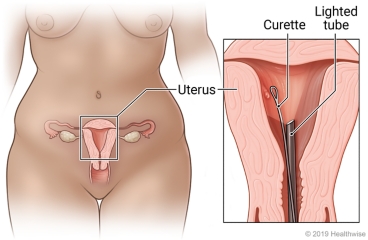
Your Recovery
For a hysteroscopy, your doctor guides a lighted tube through your cervix and into your uterus. This helps the doctor see inside your uterus.
For a dilation and curettage (D&C), your doctor uses a curved tool, called a curette, to gently scrape tissue from your uterus.
After these procedures, you are likely to have a backache or cramps similar to menstrual cramps. Expect to pass small clots of blood from your vagina for the first few days. You may have light vaginal bleeding for several weeks after the D&C.
If the doctor filled your uterus with air, your belly may feel full. You may also have shoulder pain right after the procedure.
You will probably be able to go back to most of your normal activities in 1 or 2 days.
This care sheet gives you a general idea about how long it will take for you to recover. But each person recovers at a different pace. Follow the steps below to get better as quickly as possible.
How can you care for yourself at home?
 Activity
Activity
- Rest when you feel tired.
- You will probably be able to return to work the day after the procedure. But it depends on what was done and the type of work you do.
- You may have some light vaginal bleeding. Use sanitary pads until you stop bleeding. Using pads makes it easier to monitor your bleeding. Do not rinse your vagina with fluid (douche).
- Ask your doctor when it is okay for you to have sex.
 Diet
Diet
- You can eat your normal diet. If your stomach is upset, try bland, low-fat foods like plain rice, broiled chicken, toast, and yogurt.
- Drink plenty of fluids (unless your doctor tells you not to).
 Medicines
Medicines
- Your doctor will tell you if and when you can restart your medicines. You will also get instructions about taking any new medicines.
- If you stopped taking aspirin or some other blood thinner, your doctor will tell you when to start taking it again.
- Be safe with medicines. Read and follow all instructions on the label.
- If the doctor gave you a prescription medicine for pain, take it as prescribed.
- If you are not taking a prescription pain medicine, ask your doctor if you can take an over-the-counter medicine.
- If your doctor prescribed antibiotics, take them as directed. Do not stop taking them just because you feel better. You need to take the full course of antibiotics.
Follow-up care is a key part of your treatment and safety. Be sure to make and go to all appointments, and call your doctor if you are having problems. It's also a good idea to know your test results and keep a list of the medicines you take.
When should you call for help?
Call 911 anytime you think you may need emergency care. For example, call if:
- You passed out (lost consciousness).
- You have chest pain, are short of breath, or cough up blood.
Call your doctor now or seek immediate medical care if:
- You have pain that does not get better after you take pain medicine.
- You cannot pass stools or gas.
- You have bright red vaginal bleeding that soaks one or more pads in an hour, or you have large clots.
- You have a vaginal discharge that has increased or that smells bad.
- You are sick to your stomach or cannot drink fluids.
- You have symptoms of a blood clot in your leg (called a deep vein thrombosis), such as:
- Pain in your calf, back of the knee, thigh, or groin.
- Redness and swelling in your leg.
- You have signs of infection, such as:
- Increased pain, swelling, warmth, or redness.
- A fever.
Watch closely for changes in your health, and be sure to contact your doctor if you have any problems.
Current as of: July 15, 2025
Author: Ignite Healthwise, LLC Staff
Clinical Review Board
All Ignite Healthwise, LLC education is reviewed by a team that includes physicians, nurses, advanced practitioners, registered dieticians, and other healthcare professionals.

